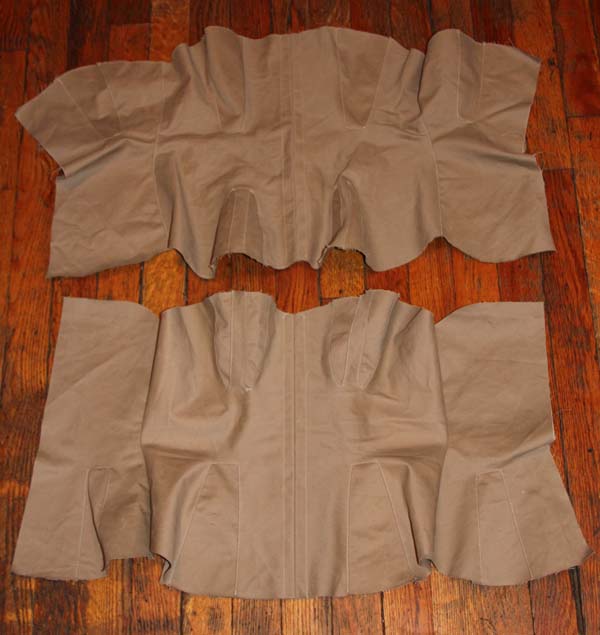Corset Report
November 17th, 2011
I’ve been neglecting my blog lately. But I have some good excuses. And this is one of them.
On Wednesday, November 9, I took part in CINCHED: Historic Corsets & Modern Corsetieres. It was a production of the New York Nineteenth Century Society, with six corset makers, one master of ceremonies, one very efficient organizer, and an audience of more than 60 delightful (and hopefully delighted) onlookers. We each took turns, in chronological order from 18th through early 20th centuries, describing corsets that we’d made and detailing their historical backgrounds.

In addition to helping organize the event, held at Swift Hibernian Lounge (our favorite local bar), I also hand sewed a nearly perfect version of the 1855/57 corset. In purple silk!! Okay, I know purple silk isn’t historically accurate. Though I did find a very similar mid-century corset in white silk. I just couldn’t resist that purple. And it was wonderful to work with after six versions made from canvas duck. The fit is getting so close. In fact, I think I may have cracked the code with a new shape in the side seam — more on that later. For now, it just needs a few tweaks (mostly adding the extra half inch I shaved from the hip at the side seam into the stomach gore) and it will be a very wearable garment.

I guess the back needs a little work too, smoothing the remaining puckers. But it’s still close. Best part about wearing this at the event? One of the other corsetieres, and a professional designer, gave me some tips on making the gores fit better!
And yes, that’s me, parading around in my underwear in a bar. Again.
Photographs courtesy of Nidal Nasr, who generously volunteered his time and talent to document the event.
Stays, and Stays
October 27th, 2011
I think, fingers crossed, I’ve finally done it. I lost count long ago of how many iterations I’ve made of this pattern for stays (originally from Peterson’s, 1855). At least six. And here are the last two.

The one at the top fits perfectly — or comes very close to doing so. There are still some persistent wrinkles around the waist, but I think I’ve reduced them as much as I can with redrafting. The rest will be done with boning. It’s actually a rather dreadful pattern for stays. I’ve seen extent stays from the 1840s and from the 1860s that deal with the hip curve (raison des plis) in a much better way — either with a deep gore that wraps all the way around the side of the hip, or with a separate curved hip piece. Maybe this pattern was meant to be more like the deep side gore, circa 1840, but the picture and directions from Peterson’s led me back time and again to these smallish front slanting gores.
Now to make them in some nice fabric for a change!
Twill Tape!
October 26th, 2011
Am I strange to become so excited by a roll of twill tape? 72 whole yards?

Just think how much corset boning this will hold in! And it’s good for binding stays too, if you don’t care about strict period accuracy…
Oh, So Close
March 31st, 2011
While battling a spring cold, I’ve been finishing my latest stay mock-up. I decided to sew these by machine — partly because there is simply too little time in life to hand-sew mock-ups, but mostly because I’m using a ridiculously heavy brushed twill that is completely impossible to hand-sew.
The good news is that they fit MUCH better now that I’ve changed the angle of the stomach gores. I also figured out that the key to a straight busk is not so much the rigidity of the material used, but the width. Two half-inch spring steel stays running next to one another are far superior to the same two spring steels stacked one on top of the other!
They are also incredibly comfortable. I’ve been wearing them for almost an hour now, and am in no hurry to take them off. I actually enjoy the support.
Here’s the bad news. I’ve got horizontal wrinkles. Ah me. I don’t remember if they were this pronounced in the last version. So many other things were wrong there that I might not have noticed. It seems these can be caused by too much length, though I don’t really think that’s the problem here. They can also be a lack of boning, but I think the folds are too severe to be fixed by an extra bone. So that means I have the gussets or side seam in the wrong place. Perhaps too close to the center front? Alas, alack. More fitting.
It does seem to improve a little when I tug the stays higher, but they always fall back down again. The back is kind of wrinkly all the way down, but I think it’s alright. Unlike the front, the back is cut on the straight grain, so it’s got less of that forgiving stretch. It’s definitely a problem in the front.
Suggestions welcome! I am off to beg advice wherever I can find it.
P.S. I do feel quite justified in using my sewing machine as this pattern was published by Peterson’s and Godey’s in 1855 and 1857 respectively. And the sewing machine was definitely making inroads into American homes by then!
I Need Coutil
March 21st, 2011
I’m working on a new mock-up, trying out the reworked stomach and hip gores for my ongoing battle of the stays. I am so tired of mock ups. So last night, I started day dreaming (can one day dream at night?) about the far-distant time when I will finally make a real, functional pair of stays. It seems I need coutil. Though I am not sure if the coutil I need is the same as the fabric currently sold under the name coutil.
According to Godey’s 1857 (via Peterson’s 1855) stay pattern, I need half a yard of material. But what kind of material? The Workwoman’s Guide says “If for ladies, they are made of satine, or best French jean… if of an inferior quality, they are made of white, brown, grey, or nankeen jean… and lined with calico between the doubles.”
According to Dictionary of Textiles, 1920:
Corset Jean—Very strong, stout jean, made of pure cotton or linen, in twill or broken twill weave, in white, and for corsets, etc.
Coutille—French jean of zigzag pattern for corsets. See Coutil 4.
Coutil—1, French and German stout drills, made of linen, hemp or cotton; 2, French and English fabrics, made of pure cotton; used for bedcovers, drapery, trousers, etc., often printed; 3, a fine worsted trousering in France; 4, very strong, stout cotton or linen fabric, woven in herringbone twill; used for corsets.
Satine—Cotton satin, see sateen.
Sateen—Stout, lustrous piece dyed cotton fabric, made in satin weave (see) either in warp or filling flush. Also comes printed or in stripes; used for lining dresses, skirts, shoe lining, etc.
Which would explain why the 1840s stays in the Met Collection that I posted about last week look like they are made of polished cotton. They are satine!
An important note — while The Workwoman’s Guide stays are meant to be double-thick and lined, the Godey’s/Peterson’s are single layer. So satine may be too flimsy for that kind of construction. I may eventually try the pattern with a double layer, but for now, I just want to get it right as written. I believe a nice stout coutil is what I’m after.
There. A hopelessly arcane and dull post with absolutely no pictures. Blech.
Older Posts »


